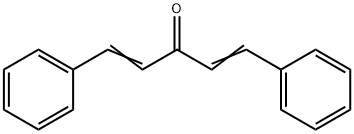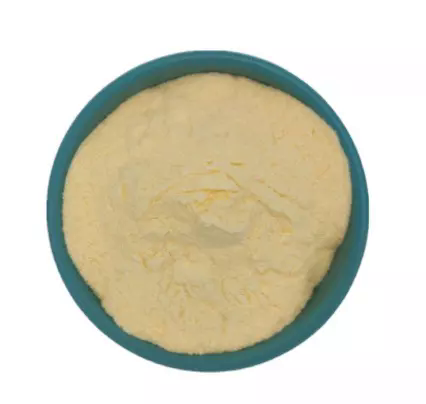Dibenzylideneacetone
Synonym(s):trans,trans-1,5-Diphenyl-1,4-pentadien-3-one;1,5-Diphenyl-1,4-pentadien-3-one
- CAS NO.:538-58-9
- Empirical Formula: C17H14O
- Molecular Weight: 234.29
- MDL number: MFCD00004790
- EINECS: 208-697-5
- SAFETY DATA SHEET (SDS)
- Update Date: 2025-07-04 15:16:11

What is Dibenzylideneacetone?
Chemical properties
trans,trans-Dibenzylideneacetone is a crystalline solid, melting point 110-111℃; cis-trans is a light yellow needle crystal, melting point 60℃; cis-cis is a yellow oily liquid, boiling point 130℃ (2.7Pa). Soluble in ethanol, acetone, chloroform, insoluble in water.
The Uses of Dibenzylideneacetone
Dibenzylideneacetone is used as a ligand to prepare palladium catalysts, which are widely used in catalytic hydrogenation, coupling, carbonylation, alkyne ring trimerization, etc.
Preparation
Dibenzylideneacetone is obtained by the reaction of benzaldehyde and acetone. The reaction was carried out in aqueous ethanol solution at a reaction temperature of 20-25°C with a yield of 78%.
Synthesis Reference(s)
Chemistry Letters, 9, p. 51, 1980
The Journal of Organic Chemistry, 45, p. 3840, 1980 DOI: 10.1021/jo01307a022
Organic Syntheses, Coll. Vol. 2, p. 167, 1943
Biological Activity
Dibenzylideneacetone (DBA) showed inhibitory activity against Botrytis cinerea Chitinase with an IC50 of 13.10 μg/mL. The MIC of DBA against B. cinerea was 32 μg/mL, and the EC50 values for inhibition of hyphae growth and spore germination were 16.29 and 14.64 μg/mL, respectively. DBA was able to significantly extend the shelf life of cherry tomato shelf life and is a promising antifungal agent for fruit preservation[1].
Purification Methods
Crystallise the ketone from hot ethyl acetate (2.5mL/g) or EtOH. [Beilstein 7 IV 1747.]
References
[1] XIAODI NIU; Chenyang W; Ziyou Wang, HONGSU WANG*. Dibenzylideneacetone Overcomes Botrytis cinerea Infection in Cherry Tomatoes by Inhibiting Chitinase Activity[J]. Journal of Agricultural and Food Chemistry, 2023. DOI:10.1021/acs.jafc.3c05695.
Properties of Dibenzylideneacetone
| Melting point: | 107-113 °C |
| Boiling point: | 336.62°C (rough estimate) |
| Density | 1.0477 (rough estimate) |
| refractive index | 1.5000 (estimate) |
| storage temp. | Sealed in dry,Room Temperature |
| form | solid |
| color | yellow |
| Stability: | Stable. Incompatible with strong oxidizing agents. Combustible. |
| CAS DataBase Reference | 538-58-9(CAS DataBase Reference) |
| EPA Substance Registry System | 1,4-Pentadien-3-one, 1,5-diphenyl- (538-58-9) |
Safety information for Dibenzylideneacetone
| Signal word | Warning |
| Pictogram(s) |
 Exclamation Mark Irritant GHS07 |
| GHS Hazard Statements |
H302:Acute toxicity,oral H315:Skin corrosion/irritation H317:Sensitisation, Skin H319:Serious eye damage/eye irritation H335:Specific target organ toxicity, single exposure;Respiratory tract irritation H413:Hazardous to the aquatic environment, long-term hazard |
| Precautionary Statement Codes |
P261:Avoid breathing dust/fume/gas/mist/vapours/spray. P280:Wear protective gloves/protective clothing/eye protection/face protection. P305+P351+P338:IF IN EYES: Rinse cautiously with water for several minutes. Remove contact lenses, if present and easy to do. Continuerinsing. |
Computed Descriptors for Dibenzylideneacetone
| InChIKey | WMKGGPCROCCUDY-UHFFFAOYSA-N |
Dibenzylideneacetone manufacturer
Clickchem Research LLP
New Products
4,4-Difluoropiperidine hydrochloride tert-butyl 9-methoxy-3-azaspiro[5.5]undecane-3-carboxylate Indole Methyl Resin N-Isopropylurea N,N-Dicyclohexylcarbodiimide(DCC) MELDRUMS ACID 5-METHYLISOXAZOLE-4-CARBOXYLIC ACID Magnessium Bis glycinate Zinc ascorbate 1-bromo-2-butyne 2-acetamidophenol 9(10H)-anthracenone Erythrosin B, 4-Piperidinopiperidine 2-((4-morpholinophenylamino) (methylthio) methylene) malononitrile 2,4-dihydroxybenzaldehyde 3-(4-morpholinophenylamino)-5-amino-1H-pyrazole-4-carbonitrile Methyl 2-methylquinoline-6-carboxylate 2,6-dichloro-4-nitropyridine 4-Bromo-2-chlorobenzonitrile 2-(benzylamino)acetic acid hydrochloride 4-(tert-Butoxycarbonylamino)but- 2-ynoic acid 3,4-dihydro-2H-benzo[b][1,4]dioxepine 1-Phenyl-1-cycloprppanecarboxylicacidRelated products of tetrahydrofuran








You may like
-
 538-58-9 Dibenzylideneacetone 98%View Details
538-58-9 Dibenzylideneacetone 98%View Details
538-58-9 -
 Dibenzylideneacetone 98%View Details
Dibenzylideneacetone 98%View Details -
 Dibenzylideneacetone, 98% CAS 538-58-9View Details
Dibenzylideneacetone, 98% CAS 538-58-9View Details
538-58-9 -
 1,5-DIPHENYL-1,4-PENTADIEN-3-ONE CAS 538-58-9View Details
1,5-DIPHENYL-1,4-PENTADIEN-3-ONE CAS 538-58-9View Details
538-58-9 -
 DIBENZAL ACETONE 90 % AboveView Details
DIBENZAL ACETONE 90 % AboveView Details
538-58-9 -
 Dibenzylideneacetone (CAS No. 538-58-9)View Details
Dibenzylideneacetone (CAS No. 538-58-9)View Details
35225-79-7 -
 20677-73-0 (2,2-diethoxyethyl)methylamine 98%View Details
20677-73-0 (2,2-diethoxyethyl)methylamine 98%View Details
20677-73-0 -
 3-(4-(hydroxyamino)-1-oxoisoindolin-2-yl)piperidine-2,6-dione 98%View Details
3-(4-(hydroxyamino)-1-oxoisoindolin-2-yl)piperidine-2,6-dione 98%View Details
